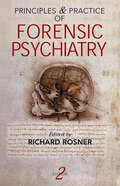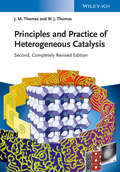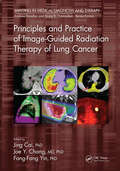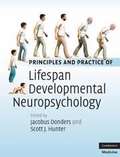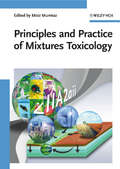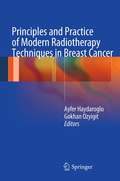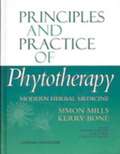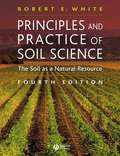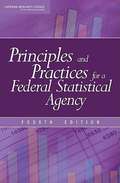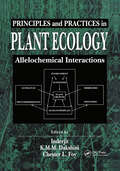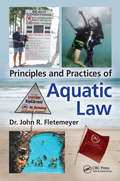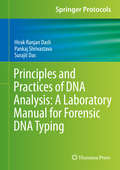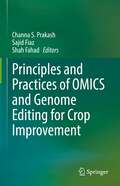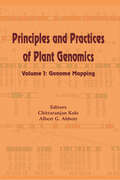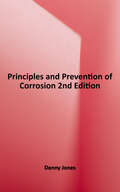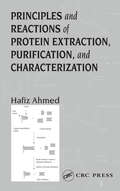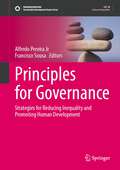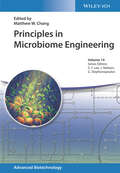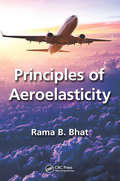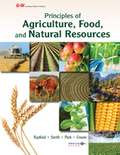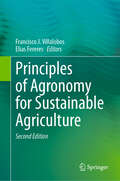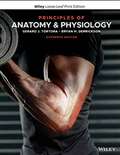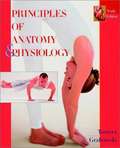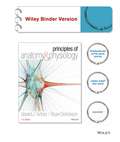- Table View
- List View
Principles and Practice of Forensic Psychiatry, 2Ed
by Yasuhiro MondenThe second edition of this award-winning textbook has been thoroughly revised and updated throughout. Building on the success of the first edition, the book continues to address the History and Practice of Forensic Psychiatry, Legal Regulation of the Practice of Psychiatry, Psychiatry in relation to Civil Law, Criminal Law, and Family Law. Importan
Principles and Practice of Heterogeneous Catalysis
by John Meurig Thomas W. John ThomasThis long-awaited second edition of the successful introduction to the fundamentals of heterogeneous catalysis is now completely revised and updated. Written by internationally acclaimed experts, this textbook includes fundamentals of adsorption, characterizing catalysts and their surfaces, the significance of pore structure and surface area, solid-state and surface chemistry, poisoning, promotion, deactivation and selectivity of catalysts, as well as catalytic process engineering. A final section provides a number of examples and case histories.With its color and numerous graphics plus references to help readers to easily find further reading, this is a pivotal work for an understanding of the principles involved.
Principles and Practice of Image-Guided Radiation Therapy of Lung Cancer (Imaging in Medical Diagnosis and Therapy)
by Jing Cai Joe Y. Chang Fang-Fang YinThis book gives a comprehensive overview on the use of image-guided radiation therapy (IGRT) in the treatment of lung cancer, covering step-by-step guidelines for clinical implementations, fundamental principles and key technical advances. It covers benefits and limitations of techniques as well as quality and safety issues related to IGRT practice. Addresses imaging simulation, treatment planning, verification, and delivery Discusses important quality assurance issues Describes current methods using specialized machines and technologies Jing Cai, PhD, is an Associate Professor of Radiation Oncology at Duke University Medical Center. Joe Y. Chang, MD, PhD, is Professor in the Department of Radiation Oncology at The University of Texas MD Anderson Cancer Center in Houston. Fang-Fang Yin, PhD, is Chief of the Division of Radiation Physics, Professor of Radiation Oncology, and Director of the Medical Physics program at Duke University.
Principles and Practice of Lifespan Developmental Neuropsychology
by Jacobus Donders Scott J. HunterLifespan developmental neuropsychology is the study of the systematic behavioral, cognitive, and psychosocial changes and growth that occur across infancy, adolescence, adulthood and later life. This book provides insight into how brain-behavior relationships change over time, how disorders differ in presentation across the lifespan, and what longer-term outcomes look like. Providing practical guidance in a succinct and accessible format, this book covers the most common neurodevelopmental, behavioral and cognitive disorders, including but not limited to ADHD, cerebral palsy, traumatic brain injury, and epilepsy. Key points concerning the practice of developmental neuropsychology are emphasized in order to aid understanding of neuropsychological development and its impact on behavior, emotion, cognition, and social integration. This will be essential reading for advanced graduate students and early career professionals in the fields of neuropsychology, pediatric psychology, clinical psychology, school psychology, and rehabilitation psychology, as well as practitioners in the allied fields that interact with neuropsychology.
Principles and Practice of Mixtures Toxicology
by Moiz MumtazThis first comprehensive treatment of the subject for more than a decade includes the latest research on nanoparticle toxicology. The practical handbook addresses all areas where toxic mixtures are encountered, from environmental via occupational to medical settings, giving special consideration to air and water, and to the specific requirements for study design in mixture toxicology. While no extensive prior knowledge or toxicological experience is required, the practice-oriented case studies and examples in the second part make this the ideal companion for the professional toxicologist in industry or healthcare institutions with little time for academic study.
Principles and Practice of Modern Radiotherapy Techniques in Breast Cancer
by Ayfer Haydaroglu Gokhan OzyigitBreast cancer is the most common malignancy among the female population. With advances in systemic therapies and modern radiotherapy techniques, breast cancer patients can have a long life-expectancy. However, it is crucial that radiation therapy is carried out with minimum complications and with the utmost efficiency. Principles and Practice of Modern Radiotherapy Techniques in Breast Cancer provides practical and current theoretical knowledge to the planning and implementation of breast cancer radiation therapy. All aspects of breast cancer are covered, including epidemiology, molecular and biological basis and integrating systemic therapies during all steps of treatment. The illustrated section of this book identifies anatomical structures in daily practice by presenting target and critical structures in actual treatment positions. These images show and mark the anatomical points of the patient lying in the position that breast radiation therapy would be performed. This text serves as a valuable resource for clinicians, residents and fellows practicing and learning breast cancer radiotherapy.
Principles and Practice of Phytotherapy
by Simon Mills Kerry Bone Desmond Corrigan James A. Duke Jonathan W. WrightThis book provides a detailed, practical and, where possible, research-based rationale for the use of herbal treatments in a wide variety of clinical conditions and problems. Through the filter of current scientific literature, the authors have reevaluated traditional use of herbal remedies and present realistic guidelines for modern practice. A uniquely authoritative guide to applying herbal medicines as serious options for the treatment of some of the most troublesome conditions seen today. In particular, this book gives: * A clear description of the principles and foundations for the practice of phytotherapy * In-depth and detailed profiles of over 45 herbs, reviewing pharmacology, research, and traditional use * Therapeutics for actual disease states, supported by case histories * Coverage of challenging issues such as dosage, safety, and drug-herb interactions
Principles and Practice of Soil Science: The Soil as a Natural Resource
by Robert E. WhitePrinciples and Practice of Soil Science, Fourth Editionprovides a current and comprehensive introduction to soil science for students in the fields of environmental and agricultural science, ecology, soil and land management, natural resource management and environmental engineering. Covers all aspects of soil science including soil habitat, processes in the soil environment and soil management. Emphasizes the applications of soil science to the solution of practical problems in soil and land management. Highlights real world examples drawn from the author’s international experience in the field. Includes an expanded colour section of soil profiles and other features, and greater coverage of international soil classification Features new problem sets and questions at the end of each chapter, designed to reinforce important principles. An answer key is provided at the end of the text. Artwork from the book is available to instructors online at www.blackwellpublishing.com/white
Principles and Practices for a Federal Statistical Agency: FOURTH EDITION
by National Research Council of the National AcademiesSince 1992, the Committee on National Statistics (CNSTAT) has produced a book on principles and practices for a federal statistical agency, updating the document every 4 years to provide a current edition to newly appointed cabinet secretaries at the beginning of each presidential administration. This fourth edition presents and comments on four basic principles that statistical agencies must embody in order to carry out their mission fully: (1) They must produce objective data that are relevant to policy issues, (2) they must achieve and maintain credibility among data users, (3) they must achieve and maintain trust among data providers, and (4) they must achieve and maintain a strong position of independence from the appearance and reality of political control. The book also discusses 11 important practices that are means for statistical agencies to live up to the four principles. These practices include a commitment to quality and professional practice and an active program of methodological and substantive research. This fourth edition adds the principle that statistical agencies must operate from a strong position of independence and the practice that agencies must have ongoing internal and external evaluations of their programs.
Principles and Practices in Plant Ecology: Allelochemical Interactions
by Chester L. Foy Inderjit K.M.M. DakshiniPrinciples and Practices in Plant Ecology: Allelochemical Interactions provides insights and details recent progress about allelochemical research from the ecosystem standpoint. Research on chemical ecology of allelochemicals in the last three decades has established this field as a mature science that interrelates the research of biologists, weed and crop scientists, agronomists, natural product chemists, microbiologists, ecologists, soil scientists, and plant physiologists and pathologists. This book demonstrates how the influence of allelochemicals on the various components of an ecosystem-including soil microbial ecology, soil nutrients, and physical, chemical, and biological soil factors-may affect growth, distribution, and survival of plant species. Internationally renowned exper†s discuss how a better understanding of allelochemical phenomena can lead to true sustainable agriculture.
Principles and Practices of Aquatic Law
by John Robert FletemeyerPrinciples and Practices of Aquatic Law presents the best practices and principles related to aquatic law and risk management. Its focus is injury and death occurring in aquatic environments including the ocean, pools, water parks, canals, rivers, lakes, dams, etc. It discusses the importance of aquatic risk management as it relates to aquatic accident prevention and the concept of duty and liability for a facility’s management and staff. It also presents updated and relevant information about beach safety and the importance of hazard identification, warning, and elimination, and provides information for attorneys relating to the process of developing liability theories involving serious aquatic accidents and death. Features Presents a comprehensive resource on the applied practices and principles of aquatic law. Provides information for attorneys for the process of developing liability theories involving serious aquatic accidents and death. Presents updated and relevant information about beach safety and the importance of hazard identification, warning, and elimination. Discusses water-borne contaminants such as cryptosporidium and flesh-eating bacteria. Presents comprehensive public safety and beach management strategies: rip current prediction and monitoring, coastal engineering, drowning and rescue statistics, etc.
Principles and Practices of DNA Analysis: A Laboratory Manual for Forensic DNA Typing (Springer Protocols Handbooks)
by Surajit Das Hirak Ranjan Dash Pankaj ShrivastavaThe book presents hands-on protocols for conventional and advanced forensic DNA fingerprinting experiments. It includes manual, semi-automatic, and advanced automatic techniques for DNA extraction from different biological samples.It also discusses various qualitative and quantitative approaches for the assessment of extracted forensic DNA. It contains protocols for the amplification of short tandem repeat markers (STRs) for the amplification-based target enrichment of the forensic samples.Further, it examines genotyping of the STR loci through capillary electrophoresis and includes real-world case studies where forensic DNA analysis has been used in the criminal and civil disputes. The book concludes by presenting technological developments in the field of DNA forensic analysis. Suitable for beginners, it is a key reference resource on a wide variety of DNA profiling techniques and applications.
Principles and Practices of OMICS and Genome Editing for Crop Improvement
by Shah Fahad Channa S. Prakash Sajid FiazGlobal food security is increasingly challenging in light of population increase, the impact of climate change on crop production, and limited land available for agricultural expansion. Plant breeding and other agricultural technologies have contributed considerably for food and nutritional security over the last few decades. Genetic engineering approaches are powerful tools that we have at our disposal to overcome substantial obstacles in the way of efficiency and productivity of current agricultural practices. Genome engineering via CRISPR/Cas9, Cpf1, base editing and prime editing, and OMICs through genomics, transcriptomics, proteomics, phenomics, an metabolomics have helped to discover underlying mechanisms controlling traits of economic importance. Principle and Practices of OMICs and Genome Editing for Crop Improvement provides recent research from eminent scholars from around the world, from various geographical regions, with established expertise on genome editing and OMICs technologies. This book offers a wide range of information on OMICs techniques and their applications to develop biotic, abiotic and climate resilient crops, metabolomics and next generation sequencing for sustainable crop production, integration bioinformatics, and multi-omics for precision plant breeding. Other topics include application of genome editing technologies for food and nutritional security, speed breeding, hybrid seed production, resource use efficiency, epigenetic modifications, transgene free breeding, database and bioinformatics for genome editing, and regulations adopted by various countries around globe for genome edited crops. Both OMICs and genome editing are vigorously utilized by researchers for crop improvement programs; however, there is limited literature available in a single source. This book provides a valuable resource not only for students at undergraduate and postgraduate level but also for researchers, stakeholders, policy makers, and practitioners interested in the potential of genome editing and OMICs for crop improvement programs.
Principles and Practices of Plant Genomics, Vol. 1: Genome Mapping (Nextgen Agriculture)
by Albert G. Abbott Chittaranjan KoleGenome of an organism is depicted by genetic linkage mapping and physical mapping. Genome mapping stated with genetic linkage mapping and contributed enormously in genome analysis and its improvement. Physical mapping emerged later and is the prelude to structural and functional genomics. Volume One of Principles and Practices of Plant Genomics introduces the historical background of genome mapping, and delineates modern methods in the field. This volume briefly introduces the historical background and overview on genome mapping. Chapters deliberating on different types of molecular markers, their detection, relative merits, shortcomings and applications; types of mapping populations, methods of their generation, applications; basic concepts and schematic depiction of construction of genetic linkage maps; concepts and strategies of mapping genes controlling qualitative and quantitative traits on framework genetic linkage maps; rationale, methodologies and implications of comparative mapping; principles, strategies, and outcome of map-based cloning; overviews on the recent advances on plant genomics and genome initiatives; and finally computer strategies and software.
Principles and Prevention of Corrosion, 2nd Edition
by Denny JonesFor a senior/graduate-level course in corrosion. Comprehensive in approach, this text explores the scientific principles and methods that underlie the cause, detection, measurement, and prevention of many metal corrosion problems in engineering practice. Most chapters progress from qualitative, descriptive sections (including methods of prevention and testing) to more quantitative sections (involving metallurgy and electrochemistry) and, finally, to sections on current research developments in the chapter topic.
Principles and Reactions of Protein Extraction, Purification, and Characterization
by Hafiz Ahmed Hafiz Ahmed PhDPrinciples and Reactions of Protein Extraction, Purification, and Characterization provides the mechanisms and experimental procedures for classic to cutting-edge techniques used in protein extraction, purification, and characterization. The author presents the principles and reactions behind each procedure and uses tables to compare the different
Principles and Techniques of Biochemistry and Molecular Biology
by Keith Wilson John WalkerThis best-selling undergraduate textbook provides an introduction to key experimental techniques from across the biosciences. It uniquely integrates the theories and practices that drive the fields of biology and medicine, comprehensively covering both the methods students will encounter in lab classes and those that underpin recent advances and discoveries. Its problem-solving approach continues with worked examples that set a challenge and then show students how the challenge is met. New to this edition are case studies, for example, that illustrate the relevance of the principles and techniques to the diagnosis and treatment of individual patients. Coverage is expanded to include a section on stem cells, chapters on immunochemical techniques and spectroscopy techniques, and additional chapters on drug discovery and development, and clinical biochemistry. Experimental design and the statistical analysis of data are emphasised throughout to ensure students are equipped to successfully plan their own experiments and examine the results obtained.
Principles for Governance: Strategies for Reducing Inequality and Promoting Human Development (Sustainable Development Goals Series)
by Alfredo Pereira Francisco SousaThis edited volume provides strategies for reducing inequality and promoting human development through the use of innovative digital technology and the adoption of new bioethical principles for governance. The book is structured around a series of practical proposals which can be adapted to different circumstances, countries, and political systems. Written by an interdisciplinary panel of international researchers and professionals, each chapter details a proposal for a policy—new social technology, Green Deals, robust social assistance—that will move society forward towards a sustainable, digital, and equitable future. Researchers across multiple disciplines--public administration, cognitive technology, E-learning, finance, philosophy of economy, agronomics, forest engineering, bioethics and education—will find this volume a useful reference.
Principles in Microbiome Engineering (Advanced Biotechnology)
by Jens Nielsen Gregory Stephanopoulos Sang Yup LeePrinciples in Microbiome Engineering Provides an overview of the techniques and applications insight into the complex composition and interactions of microbiomes Microbiomes, the communities of microorganisms that inhabit specific ecosystems or organisms, can be engineered to modify the structure of microbiota and reestablish ecological balance. In recent years, a better understanding of microbial composition and host-microbe interactions has led to the development of new applications for improving human health and increasing agricultural productivity and quality. Principles in Microbiome Engineering introduces readers to the tools and applications involved in manipulating the composition of a microbial community to improve the function of an eco-system. Covering a range of key topics, this up-to-date volume discusses current research in areas such as microbiome-based therapeutics for human diseases, crop plant breeding, animal husbandry, soil engineering, food and beverage applications, and more. Divided into three sections, the text first describes the critical roles of systems biology, synthetic biology, computer modelling, and machine learning in microbiome engineering. Next, the volume explores various state-of-the-art applications, including cancer immunotherapy and prevention of diseases associated with the human microbiome, followed by a concluding section offering perspectives on the future of microbiome engineering and potential applications. Introduces a variety of applications of microbiome engineering in the fields of medicine, agriculture, and food and beverage products Presents current research into the complex interactions and relationships between microbiomes and biotic and abiotic elements of their environments Examines the use of technologies such as Artificial Intelligence (AI), Machine Learning (ML), and Big Data analytics to advance understanding of microbiomes Discusses the engineering of microbiomes to address human health conditions such as neuro psychiatric disorders and autoimmune and inflammatory diseases Edited and authored by leading researchers in the rapidly evolving field, Principles in Microbiome Engineering is an essential resource for biotechnologists, biochemists, microbiologists, pharmacologists, and practitioners working in the biotechnology and pharmaceutical industries.
Principles of Aeroelasticity
by Rama B. BhatIntroductory Guide on the Design of Aerospace Structures Developed from a course taught at Concordia University for more than 20 years, Principles of Aeroelasticity utilizes the author’s extensive teaching experience to immerse undergraduate and first-year graduate students into this very specialized subject. Ideal for coursework or self-study, this detailed examination introduces the concepts of aeroelasticity, describes how aircraft lift structures behave when subjected to aerodynamic loads, and finds its application in aerospace, civil, and mechanical engineering. The book begins with a discussion on static behavior, and moves on to static instability and divergence, dynamic behavior leading up to flutter, and fluid structure interaction problems. It covers classical approaches based on low-order aerodynamic models and provides a rationale for adopting certain aeroelastic models. The author describes the formulation of discrete models as well as continuous structural models. He also provides approximate methods for solving divergence, flutter, response and stability of structures, and addresses non-aeroelastic problems in other areas that are similar to aeroelastic problems. Topics covered include: The fundamentals of vibration theory Vibration of single degree of freedom and two degrees of freedom systems Elasticity in the form of an idealized spring element Repetitive motion Flutter phenomenon Classical methods, Rayleigh-Ritz techniques, Galerkin’s technique, influential coefficient methods, and finite element methods Unsteady aerodynamics, and more
Principles of Agriculture, Food, and Natural Resources: Applied Agriscience
by John S. Rayfield Kasee L. Smith Travis D. ParkNIMAC-sourced textbook
Principles of Agronomy for Sustainable Agriculture
by Francisco J. Villalobos Elias FereresThis updated second edition textbook explains the different technologies of agronomy to achieve a more sustainable agriculture, for undergraduate and graduate students of agronomy. The first section gives an overview of the crop energy balance, which covers partitioning of net radiation, and their effect on the thermal environment of the canopy. Water balance, as one of the biggest concerns under a changing climate, will also be thoroughly discussed. For the second section, the authors prepare all relevant information on crop production in relation to crop phenology, radiation interception and resource availability. With that in mind, the different agricultural techniques are analyzed in the third section, with special emphasis on quantifying the inputs required for a given target yield under specific environmental conditions. For each technique, the chapters provide guidance on improving the ratio between productivity and resource use, while ensuring sustainability.
Principles of Anatomy and Physiology
by Gerard J. Tortora Bryan H. DerricksonFrom the very first edition, Principles of Anatomy and Physiology has been recognized for its pioneering homeostatic approach to learning structure and function of the human body. The 16th edition continues to set the discipline standard by combining exceptional content and outstanding visuals for a rich and comprehensive experience. Highly regarded authors, Jerry Tortora and Bryan Derrickson motivate and support learners at every level, from novice to expert, and equip them with the skills they need to succeed in this class and beyond.
Principles of Anatomy and Physiology (10th Edition)
by Gerard J. Tortora Sandra Reynolds GrabowskiAnatomy textbook. * "Clinical Application" sections demonstrate the clinical or professional significance of the discussion. * Coverage of scientific research and breakthroughs in understanding the human body keep the book on the cutting edge.
Principles of Anatomy and Physiology 14th Edition
by Bryan Derrickson Gerard J. TortoraThis 14th edition of the phenomenally successful Principles of Anatomy and Physiology continues to set the standard for the discipline. Written and superbly illustrated for two-term, introductory Anatomy and Physiology students, this text offers a rich and complete teaching and learning environment.
